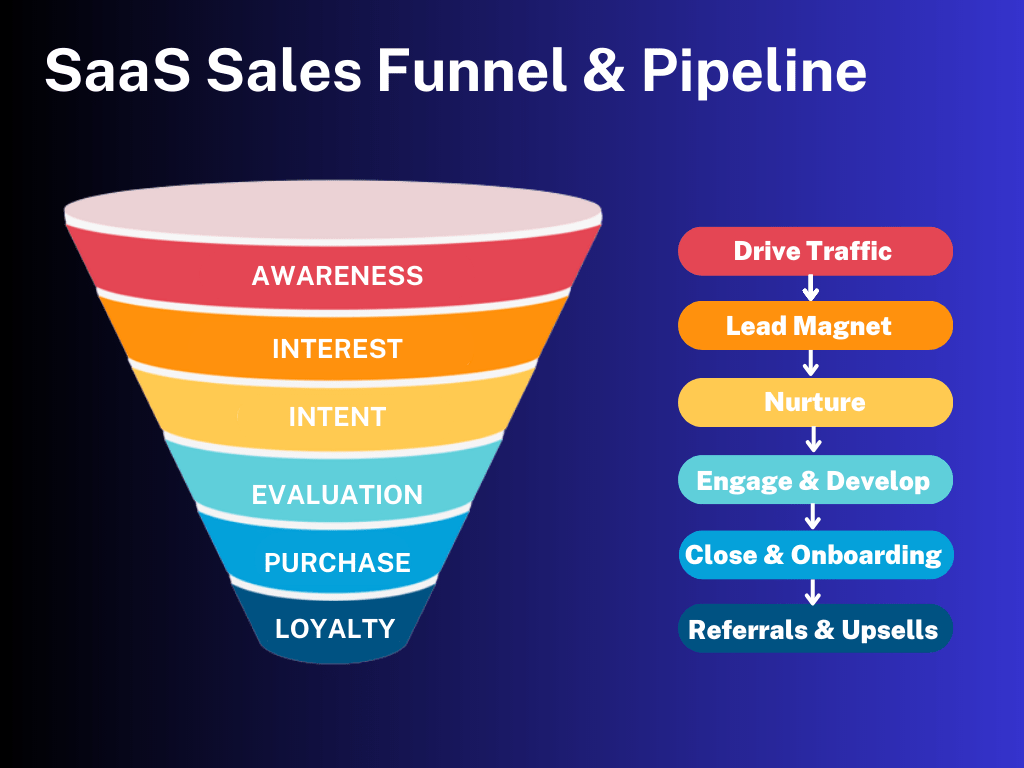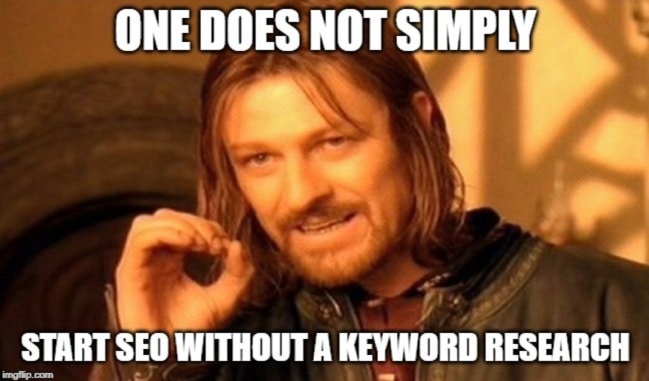In today’s highly competitive digital landscape, SEO offers numerous benefits for B2B companies. Research indicates that 90% of B2B buyers rely on online channels to gather information about new products or services–and most will engage with 3-7 pieces of content before contacting a sales representative. By implementing SEO strategies, B2B companies can boost their online presence, increase brand visibility, and attract relevant prospects searching online.
Let’s explore how SEO can be applied at each stage of the sales funnel to drive better results for your business.
Understanding the B2B Sales Funnel

Interest & Awareness Stage
During this stage, the aim is to create brand awareness, capture the interest of your target audience, and drive organic traffic to your website.
- Define your target audience and understand their pain points
- Create informative and optimized content for your audience
- Create content that allows you to capture leads (lead magnets)
Intent & Evaluation Stage
In the middle of the funnel, potential customers are actively evaluating solutions to their challenges. They’re aware of your solution but haven’t made the purchase decision yet. To succeed, focus on.
- Establish credibility and authority in your brand
- Make your solution visible and understandable
- Nurture your leads and keep engaging with your audience
Purchase & Loyalty Stage
In the final stage, potential customers are ready to make a purchase decision–and become loyal customers. Companies here should provide compelling offers, address objections, and enhance trust and reputation.
- Provide compelling offers and incentives
- Answer potential customer’s objections and doubts
- Enhance trust and reputation in your solution
- Offer referrals programs and upsell opportunities
Incorporating SEO into the B2B Sales Funnel
Let’s look at each of the stages and see how SEO can be used to improve the results of your marketing efforts.
Interest & Awareness SEO strategies
If we were to make an analogy of this stage with a real-world scenario it would be window-shopping. To make your product look good, you need to make it appealing, and more importantly, you need to place your windows somewhere visible.
When it comes to the online world, there are two words for this stage: visibility and organic traffic.
SEO is how you’ll achieve these. After all, 61% of marketers position SEO as their top inbound strategy, and 70% think it’s better than PPC. But what aspects of SEO should you be focusing on at this stage? Well, there are two that are the most important:
- Keyword research and targeting for awareness stage content
- Optimizing website structure and technical elements
Keyword research and targeted content:

To understand user search terms and keywords, use tools like Answer the Public, Ubersuggest, and Infinite Google Suggest. These free tools identify common long-tailed phrases at the start of the buying cycle. Platforms like Quora, Reddit, and Yahoo Answers also provide valuable insights into how users express themselves and what they are searching for.
For example, for a finance B2B company offering accounting software to small businesses, its keyword research process involves:
- Identifying core keywords: such as “small business accounting software,” “cloud-based accounting software,” or “financial management tools.”
- Expanding the keyword list: using research tools to uncover related keywords and phrases and incorporating long-tail keywords like “best accounting software for real estate agents.”
- Analyzing competitor keywords: to gain additional ideas and insights.
- Refining the keyword selection: based on search volume, relevance, and competition.
After identifying these keywords, the next step is to create targeted content that addresses the user queries. This way your organic traffic for those keywords will slowly start to increase. That is, of course, if your website is also optimized.
Optimizing website structure and technical elements:
Understanding your target audience and creating content that answers their queries is great, but you need to ensure your whole website is optimized as well. Otherwise, it won’t rank and it won’t give your users a positive experience.
Here’s how to optimize your website structure and technical elements:
- Create a clear, organized site architecture with easy navigation.
- Use user-friendly, descriptive, and keyword-rich URLs.
- Ensure mobile-friendliness and responsiveness.
- Improve loading speed by minimizing file sizes and utilizing caching.
- Structure content with proper heading tags, meta tags, and meta descriptions, and include relevant keywords.
- Implement schema markup for improved search result visibility.
- Utilize internal linking to connect relevant pages.
- Secure your website with HTTPS encryption for user protection and search ranking benefits.
By implementing these optimization techniques, you can improve the technical aspects of your website, providing a better user experience and increasing search engine visibility.
Intent & Evaluation SEO strategies
This stage is crucial for gaining the trust of your customers and establishing yourself as a credible source and expert in your field. At this stage, two important SEO strategies will help you beat the competition:
- Creating educational and informative content
- Utilizing link-building and guest posting for credibility
Creating educational and informative content:
This includes creating blog posts, reports, guides, and case studies. By demonstrating expertise and offering valuable insights, you’ll be positioned as a trusted resource.
In this stage, you’ll also continue conducting keyword research to narrow down your niche. Focus on high-conversion, low-traffic keywords for targeted impact.
Utilizing link-building and guest posting for credibility:

Link-building is an essential SEO strategy for establishing authority and credibility–and an Ahrefs study showed that the more backlinks a page has, the more organic traffic it gets. By acquiring high-quality backlinks from reputable websites, you can enhance your website’s visibility and reputation in your industry.
Guest posting involves contributing informative articles or blog posts to relevant industry publications or authoritative websites, which allows you to build credibility and improve your link-building game.
For instance, a healthcare B2B company offering medical equipment can collaborate with reputable healthcare blogs or industry-specific websites. By guest posting on topics like equipment innovations and industry trends, they can include relevant backlinks, showcase expertise, and drive traffic to their site.
These SEO strategies will engage potential customers, build credibility, and position companies as reliable resources in the industry.
Purchase & Loyalty SEO strategies
We’ve finally arrived at the final stage: purchase and loyalty. At this stage optimizing key product and pricing pages for search visibility and using comparison articles and case studies for trust-building are a must.
Optimizing key landing pages for search visibility:
- Conduct keyword research to find the final objections and reasons that might be stopping your potential customers from making the purchase, and address them. Things like ‘Is X product better than Y product,’ ‘How much does the subscription to X service cost,’ or ‘When will I see results with X service’ will be the kind of queries you’ll be targeting at this stage.
- Incorporate relevant keywords into your landing page titles, headings, meta descriptions, and content.
- Provide comprehensive and detailed information about the product, highlighting its features and unique selling points.
- Include clear and compelling CTAs to encourage visitors to take the next step in the buying process.
Using comparison articles to address potential buyers’ objections:
Addressing potential buyers’ objections through comparison articles is an effective way to build trust. Instead of subjective self-promotion, these articles highlight the advantages of your technology solution over competitors objectively.
For example, a SaaS company offering cybersecurity solutions can create blog posts comparing their service to popular competitors. This approach increases credibility and allows potential customers to make informed decisions.
